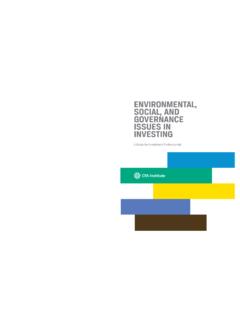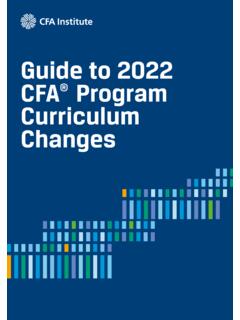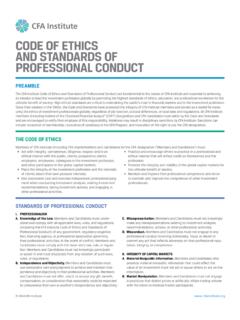Transcription of PUZZLES OF INFLATION, MONEY, AND DEBT APPLYING THE …
1 PUZZLES OF INFLATION, MONEY, AND DEBT APPLYING THE FISCAL THEORY OF THE PRICE LEVELCFA INSTITUTE RESEARCH FOUNDATION / BRIEFTHOMAS S. COLEMAN, BRYAN J. OLIVER, AND LAURENCE B. SIEGELA meritechAnonymousRobert D. ArnottTheodore R. Aronson, CFAA sahi Mutual Life Insurance CompanyBatterymarch Financial ManagementBoston CompanyBoston Partners Asset Management, P. Brinson, CFAB rinson Partners, Group International, Capital ManagementDai-Ichi Life Insurance CompanyDaiwa SecuritiesMr. and Mrs. Jeffrey DiermeierGifford Fong AssociatesJohn A. Gunn, CFAI nvestment Counsel Association of America, Levy Equity ManagementJon L. Hagler FoundationLong-Term Credit Bank of Japan, , Jones & Ryan, LLCM eiji Mutual Life Insurance CompanyMiller Anderson & Sherrerd, LLPJohn B.
2 Neff, CFAN ikko Securities Co., Life Insurance Company of JapanNomura Securities Co., & RygelProvident National BankFrank K. Reilly, CFAS alomon BrothersSassoon Holdings Pte. Stevens & ClarkSecurity Analysts Association of JapanShaw Data Securities, Investment Associates, , Ayer & Wood, Farm Insurance CompanySumitomo Life America, Rowe Price Associates, Investment Counsel Trainer, CFAT ravelers Insurance CompaniesYamaichi Securities Co., EndowmentsCFA Institute Research Foundation acknowledges with sincere gratitude the generous contributions of the Named Endowment participants listed below. Gifts of at least US$100,000 qualify donors for membership in the Named Endowment category, which recognizes in perpetuity the commitment toward unbiased, practitioner-oriented, relevant research that these firms and individuals have expressed through their generous support of CFA Institute Research more on upcoming CFA Institute Research Foundation publications and webcasts, please visit Research FellowsFinancial Services Analyst AssociationPUZZLES OF INFLATION, MONEY, AND DEBTA pplying the Fiscal Theory of the Price LevelThomas S.
3 Coleman, Bryan J. Oliver, and Laurence B. SiegelStatement of PurposeCFA Institute Research Foundation is a not-for-profit organization established to promote the development and dissemination of relevant research for investment practitioners CFA Institute Research Foundation, CFA Institute, nor the publication s edi-torial staff is responsible for facts and opinions presented in this publication. This publication reflects the views of the author(s) and does not represent the official views of CFA Institute Research Foundation. 2021 CFA Institute Research Foundation. All rights part of this publication may be reproduced, stored in a retrieval system, or transmitted, in any form or by any means, electronic, mechanical, photocopying, recording, or otherwise, without the prior written permission of the copyright publication is designed to provide accurate and authoritative information in regard to the subject matter covered.
4 It is sold with the understanding that the publisher is not engaged in rendering legal, accounting, or other professional service. If legal advice or other expert assistance is required, the services of a competent professional should be photo credit: Zhenjin Li / Moment / Getty ImagesISBN 978-1-952927-22-5 This publication qualifies for 1 PL credit under the guidelines of the CFA Institute Professional Learning We Need a New Theory of Prices and Money ..1 What Is the Fiscal Theory of the Price Level? ..3 Inflation and Money Post-2008 ..10 Conclusion ..29 Last Word ..30 Bibliography ..31 CFA Institute Research Foundation | 1 PUZZLES OF INFLATION, MONEY, AND DEBTAPPLYING THE FISCAL THEORY OF THE PRICE LEVELT homas S.
5 ColemanThomas S. Coleman is a senior lecturer and executive director of the Center for Economic Policy at the University of Chicago Harris School of Public J. OliverBryan J. Oliver is a senior analyst at Flashpoint Intelligence and a former graduate student at the University of B. SiegelLaurence B. Siegel is the Gary P. Brinson Director of Research at CFA Institute Research Foundation, Charlottesville, Virginia, and an author, speaker, and independent consultant to the investment WE NEED A NEW THEORY OF PRICES AND MONEYWe live in tumultuous times memories of an extraordinary financial crisis are still with us while we experience a once-in-a-century pan-demic.
6 Governments around the world are spending money at fabulous rates. These cir-cumstances cause us to ask, What is money and where does it come from? What determines its value, in terms of real economic resources (goods and services)? What determines the price level; what determines inflation? To answer these questions, we need a theory of money and monetary theory originally enunci-ated by David Ricardo (1817) and John Stuart Mill (1848, for example); developed by Irving Fisher (1928, for example) and John Maynard Keynes (1936, for example); and substantially revised and extended by the neoclassical econo-mists Milton Friedman, Anna Schwartz (see Friedman 1987; Friedman and Schwartz 1963), and many others of the Chicago school says that prices and inflation are determined by the quantity of money in an economy.
7 This defini-tion served economists well for much of the 20th century. It was superseded, at least among central bank and academic economists, by New Keynesian theories in which central banks con-trol inflation by targeting interest of these theories fared well after 2008, however. For nearly a decade after the global financial crisis, central banks flooded the bank-ing system with reserves and kept interest rates close to zero, as seen in Figure 1. The policy goal was to increase inflation, and yet infla-tion remained stable and low. Keynesian, New Keynesian, and Friedman s quantity theories 2 | CFA Institute Research FoundationPUZZLES OF INFLATION, MONEY, AND DEBT predict that pegging the interest rate at zero leads to unstable inflation or spiraling deflation.
8 The quantity theory of money predicts that mas-sive quantitative easing results in large inflation. None of these outcomes happened. Inflation was positive, low, and stable. The past decade s experience with the zero lower bound and low and stable inflation the divergence between evidence and the Keynesian, New Keynesian, and monetarist predictions should be recog-nized as the serious challenge that it is for both academic and central bank is inflation the only issue. Money itself has evolved beyond the boundaries of traditional theories, so that standard approaches no lon-ger provide a functioning theory of money and inflation.
9 Transactions today often involve elec-tronic bank or brokerage transfers with little or no traditional money (either cash or bank deposits). Bonds and money are nearly substi-tutes, with almost-instantaneous transfers from a bond mutual fund to a credit card payment. Central banks are considering, or have actually introduced, digital money that exists only on FIGURE 1. BANK RESERVES (PROXY, $ BILLIONS), EFFECTIVE FED FUNDS RATE, AND INFLATION (PERSONAL CONSUMPTION EXPENDITURES DEFLATOR, ANNUAL PERCENTAGE CHANGE), 2002 202104008001,2001,6002,0002,4002,8003,20 03,6004,0004, ((Mil. of $/1000)-Bil. of $)Percent Change from Year Ago , Percent((Monetary Base; Total/1000)-Currency Component of M1) (left)Personal Consumption Expenditures: Chain-type Price Index (right)Federal Funds Effective Rate (right)Sources: Board of Governors; BEAS haded areas indicate : We use the monetary base minus currency as a rough measure of reserves in the banking system.
10 This metric tracks reasonably closely the Reserves plus Vault Cash shown in the Fed s balance sheet, Table L109 of the Financial Accounts of the United States (2021).Sources: Board of Governors of the Federal Reserve; US Bureau of Economic OF INFLATION, MONEY, AND DEBTCFA Institute Research Foundation | 3 the books of the central bank, without any phys-ical manifestation (cash) or connection to the commercial banking system (demand deposits). Technological innovations such as blockchain and cryptocurrencies have the potential to dras-tically alter the use and meaning of changes in the form of money challenge classic theories of inflation and money in two ways.










